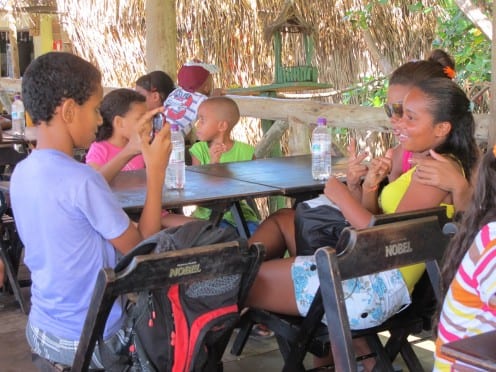
Teens at the Brazil field site. Photo by Juliano Spyer.
“If one day the sadness and the loneliness knock on your door, open and answer: ‘Hello, I cannot host you, my home is full. In the living room is Happyness, Joy, and Harmony. In one of the rooms is Love. In the other room is Affection and Tenderness. And in the kitchen is Peace and Prosperity. Fortunately the other room is under renovation to receive Victory. Have a lovely afternoon, many kisses, N.'”
Through the course of three months I have been conducting a questionnaire eith informants in my fieldsite about how they use communication services in general. The one question that has been a constant source of insights is the one that inquires about who they communicate with using social networking sites, email, Skype-like services, SMS, land line, mobile, instant messaging, and WhatsApp-like solutions.
Texting – The short text that appears at the start of the article is what texting (SMS) seems to be mostly used for. Texting is not a way of interacting with contacts, but a broadcasting tool used to deliver these kind of uplifting messages to friends and family. I supposed the “normal” function of texting is covered by voice calls through mobile phones, which are accessible to those less confortable with writing and typing on a small device. So those who have free texts on their mobile plans use it to display their affection, specially to those living in different cities from the sender.
Telephone / Skype – Landlines may be used, but only relatively rarely They are still used by some (older people in the house) to call relatives living away, but it is an expensive service to call mobile phones in general, so the few people that have access to it, either at home or at their work, use it for “institutional calls”, which translates to calling one’s college admin office, a business client, or a government office. Many also know about Skype, but have not started using it because of low internet bandwidth.
Emailing – A lot of people have email. It used to be a tool for keeping in contact with colleagues at the university that lived far away. Its advantage was to enable group communication: everyone would be in sync with the exchanges aiming to coordinate collective activities. And it is free to use by those with access to the internet. But similarly to land lines, email is becoming less important, and is typically only used for “institutional communication”. Student exchanges are currently migrating to Facebook groups.
Mobile phones are today the second most important communication device to my young informants. Mobile phones are great, but they are still costly services considering the amount of communication they want to have. The phone is there, but it is mostly a one-way communication product, as many do not have credit to make calls. In special occasions, they can make collect calls or use a special SMS service that delivers a message to another user asking that person to call back.
Social networking and Facebook
Vianna is among the Brazilian social scientists that criticize the near monopoly-stage Facebook has arrived to in Brazil. “Many people do not venture any more outside the walls of this private social network: they think that there is all there is of the large Network, forgetting that there they live in an environment controlled by a single company, working for free for their business success,” he wrote in a newspaper column [in Portuguese] earlier this year. But I am not so sure that Facebook is able to understand how it is being used. He says he refuses to call it “Face”, as if it was a personal friend, but calling it “Face” is an evidence of a cultural interpretation.
Social communication at my field site is synonymous to using Facebook together with face-to-face interactions. Facebook – or “Face”, as it is called at my field site – is the perfect tool in many regards: it is the cheapest solution to reach everyone at any time; those that connect occasionally using the services of internet cafes and those who are “always on” through mobile internet plans. It may be conceptualized as a sort of “polymedia machine” as it condenses different functions (chat, blogging, etc) and also connects the various platforms available for digital communication.
The gift of privacy and anonymity
Among Facebook’s many functions, private chatting it by far the most important among teens and young adults here. As I ask them about how many times they perform different actions, chatting is normally at a higher order of magnitude compared to other actions such as updating status, “liking”, sharing, or commenting.
I must look further into this topic, but so far I know it represents the possibility of totally private communication – one that is not accessible to anybody else but the two interacting at a given moment. Facebook chat allows people to talk to each other away from everyone else’s sight. This seems to be important at a place that has a large group of “natives” (people born and raised, with strong ties with each other) and migrants (those arriving recently and with few social ties). Anonymity and privacy facilitate social interacting under these circumstances.
Facebook is also a solution to being always near some people; a sort of SMS that is free to use and reaches friends everywhere, independently of time, space, and the mobile plan chosen. And it is also private regarding parents and older people in general since older people tend to be less interested and knowledgeble about computers and phones and are also less skilled with writing and reading.
The near future
The mobile phone has great potential that is not far from being reached. They are becoming a private mobile computer, considering their home computer is shared among the family. Cheap smart phones are already common among teens as it became a prized object of social distinction. The internet connection to phones are also accessible price-wise. The problem, at least at my field site, is that the quality of the connection and the processing capacity of phones are still low. The small screens, complicated apps and tiny keyboards make it more difficult to use the service. And still, many do it.
It is relatively easy to explain why my informants use communication devices the way the do, but I was not be able to anticipate how they use it, considering my user habits tend to be more similar with that of my age group and social class (my habits seem to be more international than Brazilian in that regard). What I believe I can anticipate now is that things are about to “catch on fire”, as Brazilians say it, as mobile internet connections becomes not just available, but friendlier in terms of user interface, processing capacity, and connection speed.
Filed under Brazil, Culture, Elderly, Low income, Migration, Parenting, Politics, Polymedia, Privacy
Tags: anonymity, bandwidth, connection, cost, middle class, mobile, polymedia, privacy, SMS, texting, value, youth
3 Comments »

 Close
Close






